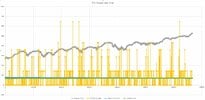derotam
Active Member
I agree the test scenarios were not clearly presented like the manual vs auto HVAC mode tests and dropping the temp to verify the current sensor also would read 0.
When changing the temp on the car there is a ramp rate where the cabin heater will try to stay off but as a steady state temp forms so does the cabin heater staying on 98% of the time.
At 24:40 the cabin heater starts getting close to steady state on above 300 watts.
I will try to make another video with clearer test conditions with clearer results but there has only been a few cases I've seen where the cabin heater is not used when only cooling is desired and thats during a couple short drives when it's 90F plus outside. When the outside temp is just a few degrees above your temp setpoint seems to be the worst case where the cabin heater is used even more.
Others like Josh Wardell who made the model 3 can dbc file verified this behavior as well. Will dig up his post.

GitHub - joshwardell/model3dbc: DBC file for Tesla Model 3 CAN messages
DBC file for Tesla Model 3 CAN messages. Contribute to joshwardell/model3dbc development by creating an account on GitHub.github.com
Turns out it was a private message. This is what he wrote, also attached the graph of his can output showing the cabin heater use.
"So here's a new shot of the same run, and I added cabin humidity as well, though that doesn't seem to really be affected (I guess you could say that shows things working).
The heaters quickly spike to 2kW each but quickly stabilized at about 800W each. But I would prefer to repeat the test for a longer time to see what the heater use averages. Of course it won't be warm enough for another 6-7 months"
So I know it's not just me. Please run a can test with your test setup if you could.
You are not fully understanding the situation. Yes you can show the cabin heater being on at the same time as the AC given specific hvac temperature set points, yes you can run a test and ONLY show what you want to show. But you can NOT prove that the cabin heater is ALWAYS on when the AC is running.
I am working on getting CAN data, but you still have not specifically confirmed to me what your stance is so it is hard to get you the data you need. I could easily show you that the PTC heater is not constantly on. You even showed that in your youtube video so I don't know what you are trying to say because what I think you are trying to say was disproven in your own youtube video. Yesterday on my way home I did some quick checks to figure out how to best get complete data and this is what I saw.
Outside temp 67F, Cabin temp started at about 90 degrees. Sunny day. Started my drive with set point at 67 to match outside temp, started my drive and waited till the PTC heater started to twitch on. Dropped set point to 62. Never saw the PTC heater twitch on again for the rest of the drive(about 15 minutes). And I will note that the HVAC wattage dropped down to idle usage as opposed to active cooling usage by the time I finished my drive.
So again, what is your claim?
If you want to claim that the PTC heater is constantly on, fine I can disprove that easily enough with CAN data
If you want to claim that the PTC heater always comes on after a defined(by you) set period of time, fine we can run that test too.
And just so everyone else understands how important this is...we are arguing over 5-16Wh/mile(at 60mph) excess usage(@beachmiles own 300-1000W numbers). Unnecessary usage, sure, life changing, no.
An additional correction to past statement, LO setting kicks on below 60F setpoint.
@beachmiles Make your claim and we will test for it and I will provide data. Data, data data, I love data.
Edit: Again, I agree that the PTC heater does come on unnecessarily in some common use scenarios, but it is not constantly on all the time.
Last edited:




